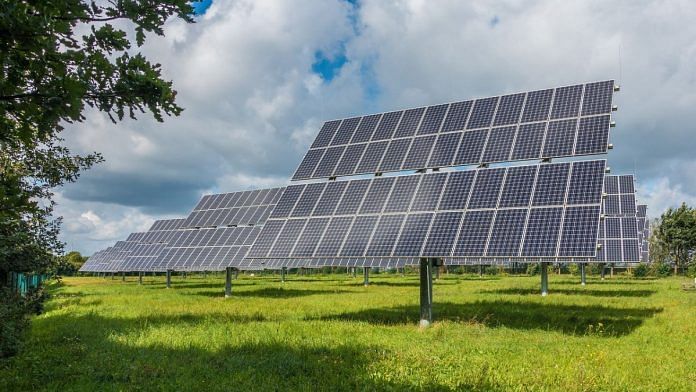Bengaluru: As India takes big steps to expand its renewable energy capacity to lower greenhouse emissions, solar energy has taken a prominent place in the country’s economy. This has resulted in the expected accumulation of waste from existing and new solar development, and these waste products will likely build up over time.
A new study by the Council on Energy, Environment and Water (CEEW) estimates that between the financial years 2024 and 2030, solar capacity can generate 600 kilotonnes of waste — the equivalent of 720 Olympic-sized swimming pools. Rajasthan, Gujarat, Karnataka, Andhra Pradesh, and Tamil Nadu will produce most of that waste, it says.
India is projected to produce nearly 292 gigawatts (GW) of solar capacity by 2030. The waste products — photovoltaic (PV) materials — generated from this growth contain minerals such as cadmium, tellurium, silicon, and silver, which are critical to India.
In this first-of-its-kind study, CEEW has calculated and estimated India-specific solar waste generation from various quarters. The data will likely be handy for practical waste management policies, some of which the Ministry of Environment, Forest and Climate Change (MoEFCC) is enacting to clear e-waste, CEEW stated.
“India must proactively address solar waste, not just as an environmental imperative but as a strategic necessity for ensuring energy security and building a circular economy. As we witness the remarkable growth of solar from only four GW in March 2015 to 73 GW in December 2023, robust recycling mechanisms become increasingly crucial,” said CEEW CEO Arunabha Ghosh in a statement.
The statement added that robust recycling mechanisms safeguard renewable ecosystems, create green jobs, enhance mineral security, foster innovation, and build resilient, circular supply chains.
CEEW is a leading climate think tank in Asia and uses data-based analysis for calculating the use, reuse, and misuse of natural resources while conducting independent research.
India’s solar power capacity as of financial year 2023 was 66.7 GW, which has generated 100 kilotonne of waste so far. According to projections, the waste would build up to 600 kilotonne by 2030, and after that, it would grow by nearly 32 times to 19,000 kilotonne by 2050.
Meanwhile, the mines ministry has classified PV materials such as silicon, copper, tellurium, and cadmium as critical, with India relying on imports to meet its requirements. Recycling solar waste will reduce import dependency and improve mineral security, the CEEW report says.
CEEW is not alone in arriving at this conclusion; the Ministry of New and Renewable Energy (MNRE) has also noted that solar PV recycling is a priority area for the development of renewables.
The existing solar infrastructure has a minimum lifespan of 25 years. However, many pieces of equipment become waste due to damage during handling, operations, or transportation. The report recommended the Indian solar industry address such logistical problems.
“A circular solar industry and responsible waste management will maximise resource efficiency and make domestic supply chains resilient. The CEEW study provides robust evidence of the opportunity in solar waste management. However, solar recycling technologies and the industry are still at a nascent stage and require policy push and support,” said CEEW senior programme lead Neeraj Kuldeep in the statement.
The report lists a series of recommendations for solar PV waste management. These include the MNRE maintaining an updated database of installed solar capacity with accurate mapping, the MoEFCC issuing guidelines for storing and processing solar waste safely, and the solar equipment producers setting up waste collection and storage centres.
(Edited by Madhurita Goswami)
Also Read: India sees 8-fold rise, adds over 52k workers in solar & wind energy sectors in FY22, study shows



